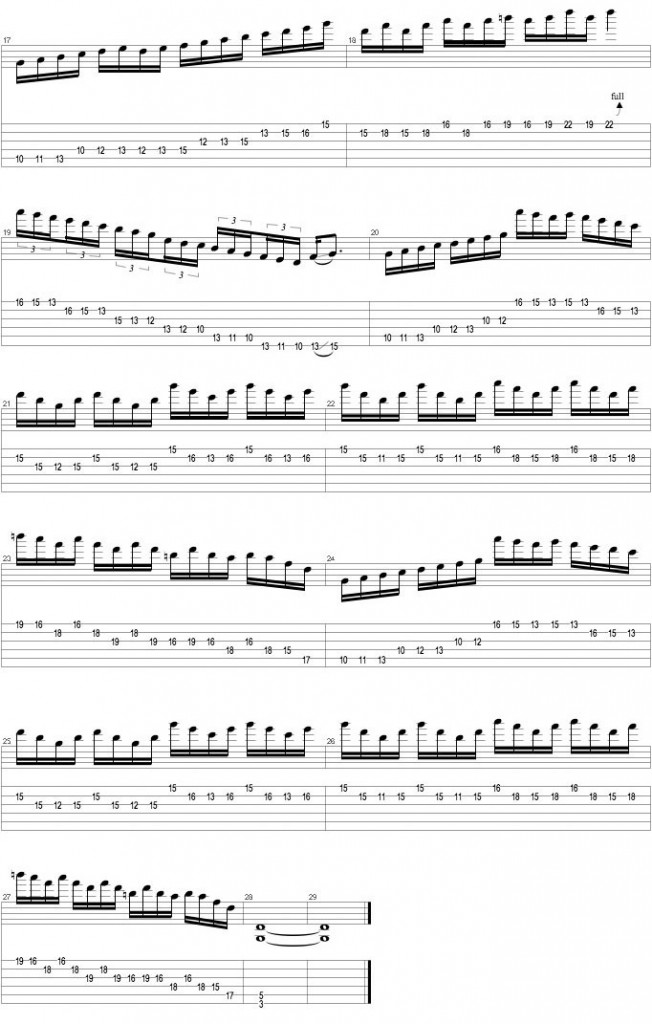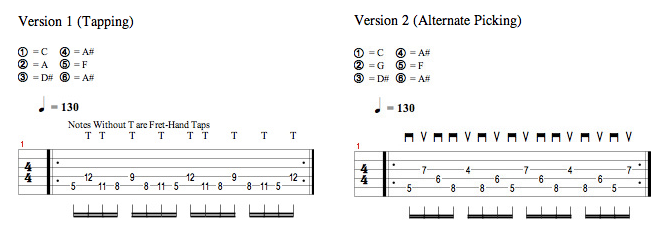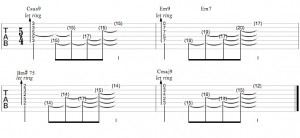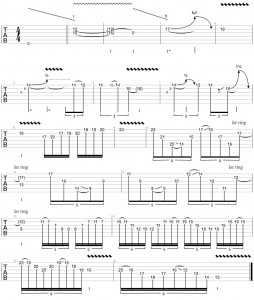- So you’ve got your metronome – (Part 1) – check.
- You understand the basics of rhythmic notation – (Part 2) – check.
- And now you’ve got a great warm up and know how to work moveable finger patterns in time – (Part 3) – check.
Now its time to apply everything you’ve learned and use them to play some licks in a real musical situation.
The following example is a minute long rock/metal/shred tune that features a medium/fast rock tempo and a series of sixteenth note runs in the G Phrygian mode. (If the modes are new to you, you may want to review your music theory but it’s not necessary to complete this lesson, just a helpful tool.) This is similar to the kind of thing that ‘metronome addicts’ like John Petrucci, Yngwie Malmsteen, Michael Romeo etc are playing. If you haven’t already, familiarize yourself with their styles and try to learn a few of your favorite songs and riffs.
| [flashvideo file=”https://guitarmessenger.com/wp-content/uploads/2008/09/playlist.xml” width=320 height=100 playlist=bottom playlistsize=80 /] |
Listen to both the song and the solo guitar arrangement a few times before attempting to jump right into learning it. Try to a get a feel for the sections; the queues of the lead versus rhythm guitars and what parts you anticipate being the most difficult. If you’re not used to working on pieces like this, a few words of hope: if you slowly attack it section by section with the variety of techniques that we have learned you’ll find its much easier than it looks/sounds. Ask your self these questions as you listen and review the score:
- Where is the fastest rhythmic grouping of notes?
- Where does most of the song take place on the neck?
- Are there any repeating lines or repetition within phrases?
- What kinds of picking patterns are being played or make the most sense?
- What instruments are acting as a metronome?
Hope you enjoy it!
The Song:
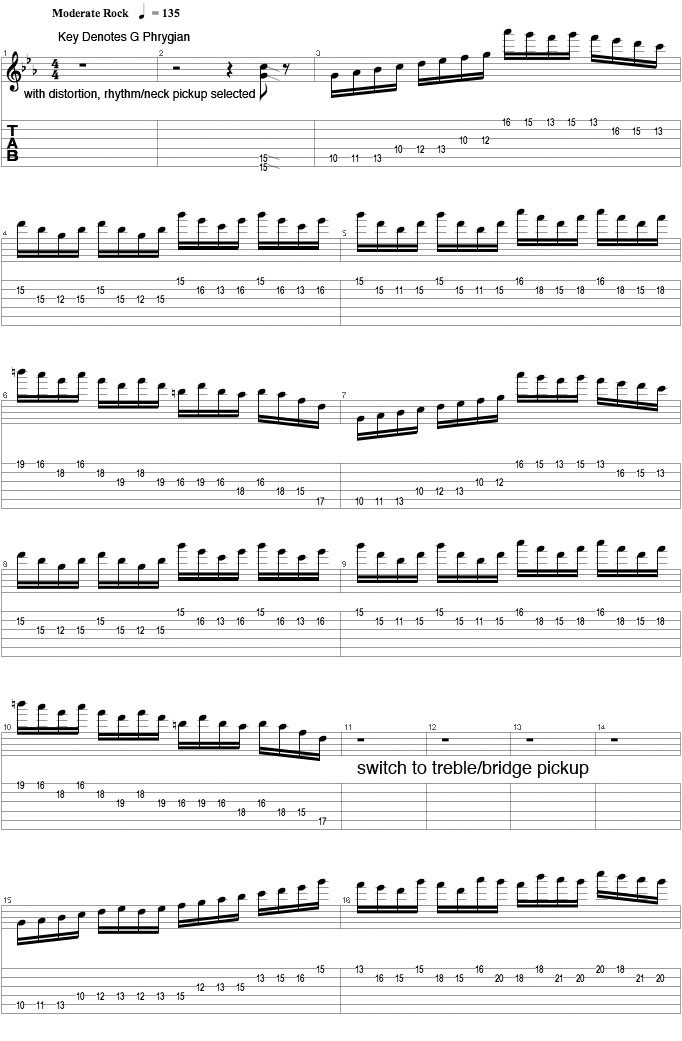
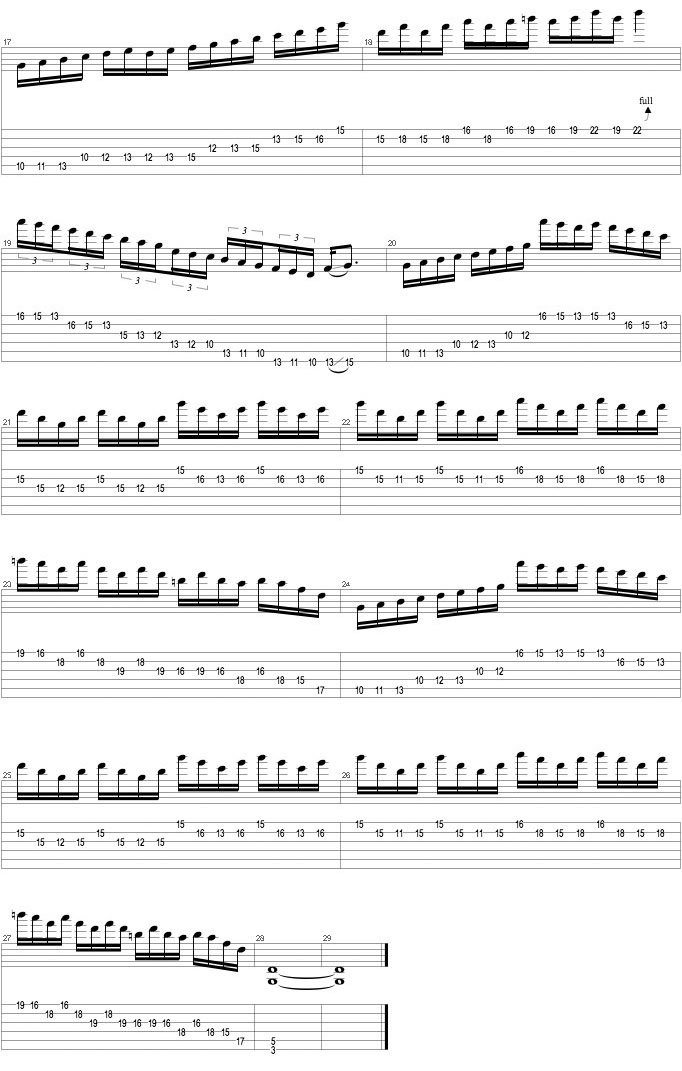
Analysis:
Now just because this is a rock tune and uses distortion does not mean you should turn up the gain right away. You’ll want to start clean so you can obtain the clarity and precision in your playing before you muddy it up with effects and amplification. Knowing guitar players, you’ll want to just dive right in, but the best way to go about learning a piece of music is to think about it like a puzzle full individual parts that ‘snap’ together and not a single giant chunk of notes.
Lets take a look at the first bar of the lead guitar:
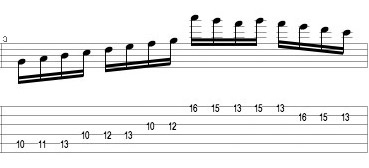
This first bar features an ascending straight G Phrygian ascending run followed by a shift up an octave on beat three. First practice moving back and forth between positions only on this passage. The warm pattern where each finger is assigned to a fret is perfectly applicable to this example. Remember to alternate pick! This is not legato! (Yet.)
If you are feeling frustrated or finding yourself fumbling over notes as you work up the pattern, follow these steps to get yourself back on track. In fact, it might be a good idea to start with these steps regardless to help memorize the finger patterns.
- Memorize the hand positions and movements
- ‘Feel’ the pulse of the metronome, hear the groove in your mind.
- Instead of 16th notes, play every note as a quarter note in time with the lick at 135 bpm
- When you feel comfortable at this speed begin playing the example as 8th notes
- When you are comfortable with the example as 8ths continue playing at that rhythmic speed, but drop the tempo to 67 bpm, (adjust slightly for the 1 bpm difference,) thereby you will be playing 16th notes, at 67 bpm.
- Now start pushing the tempo faster at a moderate acceleration. Try 16th notes at 80 bpm.
- Continue to push the tempo to 100, 120, and finally 135 bpm.
- As you increase remember to alternate pick and accent the first note in every group of sixteenths.
When you have the first passage down, move on to the second and third measures:

This grouping of phrases is simply four sets of arpeggiated chords for two beats each, moving from a Gm, to Cm, back to Gm, and the finishing with a Ddim. (I-, IV-,I-, V-). Use the above steps to work on speeding up this sequence of patterns and then put it all together with the first phrase.
The final section of the first part is as follows:
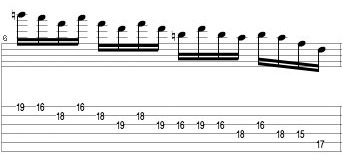
This is simply a descending Ddim7 pattern. Nothing tricky about it, just remember to alternate pick and use the steps above to move your way down. The next four bars are simply a repeat of the first four.
Use this system to follow through to the second section, (after the four-measure rest break). You’ll find that the first measure in this part is very similar to the very first bar, and the sequence that follows to be easier than it looks. After 4 bars you will reach the fastest lick in the song:

This part consists of sextuplets – for every quarter note beat there are 6 notes, and every 8th note there are 3. This you may find to be the most difficult spot in the piece.
If necessary, practice this lick ‘legato’ by simply picking the first note on every string and pulling-off the rest of them with a sharp pull to sound the notes instead of picking every note. This will be easier at first, but eventually you will want to build the speed to alternate pick it.
Conclusion
Good luck!!! Remember you won’t be able to play this in five minutes; it takes practice just to memorize the parts and hand positions. Don’t forget to ‘feel’ the piece; it can’t be emphasized enough how much grooving is a part of playing with a metronome. Take each section slowly – there is no reason to rush learning a section, ultimately making it sloppy. Don’t get into bad habits!
When you have the piece up to speed, try playing along with the backing track above! You can also click HERE to view the included rhythm guitar score for reference or to learn with a second guitarist.
In the final two parts we will get into playing the hardest rhythmic subdivisions – 32nd notes and smaller rhythms, triplet groupings, and the underestimated importance of silence and rests. And soon to come…. The uber challenge, the ultimate test of your metronomic practice!!! \m/
Also! In the Guitar Messenger Forum, please request what style of music you would like the next example to be, especially if you want more metal. I’ll do my best to aim this to what you guys are focusing on when you practice!



